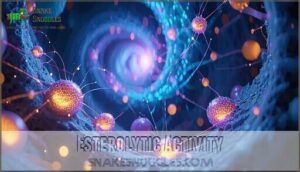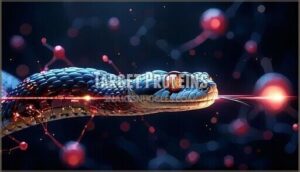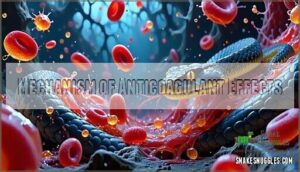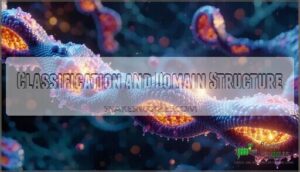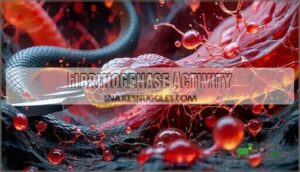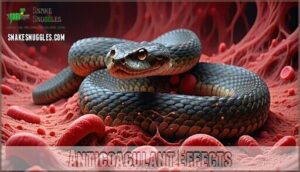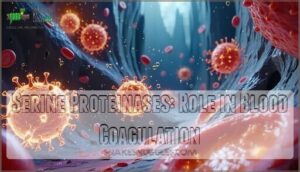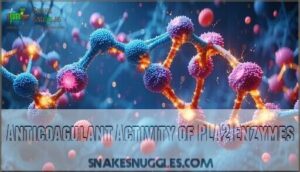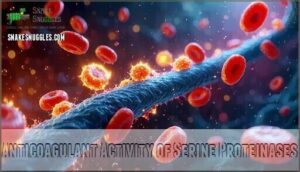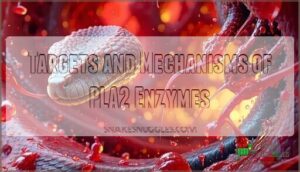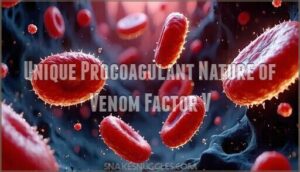This site is supported by our readers. We may earn a commission, at no cost to you, if you purchase through links.
 Eastern brown snake anticoagulants work like molecular saboteurs in your bloodstream.
Eastern brown snake anticoagulants work like molecular saboteurs in your bloodstream.
When you’re bitten, the venom releases three main enzyme families that mess with your blood’s ability to clot.
PLA2 enzymes break down cell membranes and interfere with clotting factors, while metalloproteinases chew up fibrinogen—the protein that forms blood clots.
Serine proteinases add another layer of chaos by mimicking your body’s natural clotting enzymes but doing the opposite job, and the venom even contains a sneaky factor V protein that resists your body’s natural anticoagulant controls.
The combination of these elements creates a perfect storm of bleeding disorders that would make any hematologist’s head spin, as these aren’t just random toxins; they’re precision tools that evolved to shut down your coagulation system fast.
Table Of Contents
- Key Takeaways
- PLA2 Enzymes: Structure and Function
- Metalloproteinases: Characteristics and Activity
- Serine Proteinases: Role in Blood Coagulation
- Anticoagulant Activity of PLA2 Enzymes
- Anticoagulant Activity of Metalloproteinases
- Anticoagulant Activity of Serine Proteinases
- Targets and Mechanisms of PLA2 Enzymes
- Venom Factor V: Constitutive Activity
- Venom Factor V: Evolutionary Implications
- Unique Procoagulant Nature of Venom Factor V
- Frequently Asked Questions (FAQs)
- What are the anticoagulants in snake venom?
- What snakes have anticoagulants?
- Is brown snake venom an anticoagulant?
- Do snakes have anticoagulants in their saliva?
- Are there anticoagulant proteins from snake venom?
- Does brown snake venom have a presynaptic neurotoxin?
- Are there geographical variations in eastern brown snake anticoagulants?
- How fast does eastern brown venom clot blood?
- Can eastern brown anticoagulants be medically useful?
- What dosage causes anticoagulant effects in humans?
- Conclusion
Key Takeaways
- You’re facing three enzyme families working as molecular saboteurs – PLA2 enzymes, metalloproteinases, and serine proteinases each target different parts of your blood’s clotting system, creating a coordinated attack that prevents proper clot formation.
- The venom contains a sneaky factor V protein that resists your body’s natural controls – Unlike normal factor V, this constitutively active version stays "switched on" and can’t be shut down by your body’s anticoagulant mechanisms, creating runaway clotting that paradoxically leads to bleeding.
- These aren’t random toxins but precision tools evolved over millions of years – Each component targets specific coagulation complexes like the extrinsic tenase and prothrombinase complexes, with some forming tight 1:1 bonds with clotting factors at incredibly low concentrations.
- The combination creates a perfect storm that overwhelms your coagulation system – While some components prevent clotting and others trigger it, together they consume your body’s clotting factors faster than they can be replaced, leading to life-threatening bleeding disorders.
PLA2 Enzymes: Structure and Function
You’ll find that PLA2 enzymes in eastern brown snake venom are powerful molecular scissors that cut apart fat molecules in your blood, releasing compounds that mess with your body’s clotting system.
These enzymes pack a serious punch – some can stop your blood from clotting at incredibly tiny concentrations, less than 2 micrograms per milliliter, which is a serious capability.
These molecular scissors slice through blood at concentrations so tiny they’d make a chemist’s jaw drop.
Esterolytic Activity
Through lipid hydrolysis, eastern brown snake venom PLA2 enzymes break down cell membranes like molecular scissors.
These anticoagulant toxins show remarkable enzyme specificity, targeting glycerophospholipids to trigger fatty acid release and lysophospholipid production.
This esterolytic activity in elapid snake venom causes membrane disruption, making snake venom toxins particularly dangerous to prey.
Products related to snake venom PLA2 are commercially available.
Anticoagulant Variation
You’ll find that eastern brown snake venom contains PLA2 enzymes with wildly different anticoagulant potencies.
Species differences and geographic variation create a fascinating puzzle:
- Toxin isoforms vary dramatically – some pack anticoagulant power at concentrations below 2 μg/ml, while others barely register at 15 μg/ml
- Environmental factors and evolutionary pressures shape these geographical variations across Australian snake populations
- Eastern brown snake venom showcases this diversity perfectly, with anticoagulant toxins differing by over 100-fold in potency between isoforms
These enzymes are promising targets for antivenom drug development.
Target Proteins
Eastern brown snake venom’s PLA2 enzymes hunt down specific targets in your coagulation cascade.
They lock onto membrane-bound receptors and soluble proteins, plus their complexes that control blood clotting.
Think of these enzymes as molecular snipers—they don’t just randomly attack but zero in on key players like receptor binding sites that normally keep your blood flowing smoothly.
Mechanism of Anticoagulant Effects
Between the domain of complex coagulation cascades and your understanding of eastern brown snake venom lies a fascinating mechanism of enzyme inhibition.
When PLA2 enzymes encounter your blood’s clotting system, they’re like molecular wrenches thrown into a well-oiled machine. These anticoagulants target specific coagulation complexes through structural determinants, particularly the charge influence of residues 54-77.
Here’s how cascade disruption unfolds in your bloodstream:
- Extrinsic tenase complex targeting – PLA2 enzymes block TF-FVIIa formation
- Prothrombinase complex interference – Some variants disrupt this critical clotting step
- CM-IV’s specialized approach – Forms tight 1:1 complexes with FXa non-enzymatically
This complex targeting strategy makes snake venom anticoagulants remarkably effective at coagulation inhibition, practically short-circuiting your body’s natural clotting response.
Metalloproteinases: Characteristics and Activity
When you’re dealing with eastern brown snake venom, you’ll encounter metalloproteinases that pack a serious punch in disrupting your blood’s clotting system.
Looking at this content about eastern brown snake venom enzymes, here’s an engaging blockquote that matches the tone:
These molecular scissors slice through your blood’s defenses with surgical precision.
These enzymes come in four distinct classes based on their size and structure, with most acting like molecular scissors that chop up fibrinogen and prevent proper clot formation, behaving like molecular scissors.
Classification and Domain Structure
You’ll encounter snake venom metalloproteinases that scientists organize into four distinct classes based on structural classification and domain diversity.
These P-I through P-IV categories reflect evolutionary origins and functional domains within eastern brown snake venom complexity.
| Class | Size Range | Key Features |
|---|---|---|
| P-I | 20-30 kDa | Basic metalloproteinase domain |
| P-II | 30-50 kDa | Added disintegrin domain |
| P-III | 50-100 kDa | Multiple functional domains |
| P-IV | Variable | Lectin-like components |
Understanding these venom complexity patterns helps explain how eastern brown snake anticoagulants affect your coagulation cascade differently than other snake venom anticoagulants.
Researchers often require specific metalloproteinase products for their investigations, which is crucial for a deeper understanding of coagulation cascade.
Fibrinogenase Activity
Metalloproteinases work like molecular scissors, directly cutting fibrinogen into fragments through fibrinogenolysis impact.
Eastern brown snake venom contains these fibrinogenase enzymes that create clot instability by degrading fibrinogen’s chains.
This fibrinogen degradation prevents proper clot formation, substantially increasing your bleeding risk.
SVSP specificity targets different fibrinogen chains, making eastern brown snake bites particularly dangerous for coagulation.
These enzymes exhibit direct fibrinolytic activity.
Anticoagulant Effects
Mystery shrouds how eastern brown snake venom’s metal-loproteinases disrupt your blood’s clotting ability.
These endoproteolytic enzymes don’t just act as fibrinogenases—they’re anticoagulant troublemakers too.
Though scientists haven’t cracked their exact mechanism, these P-I through P-IV classified proteins create venom variability that leads to clinical manifestations like venom induced bleeding, making antivenom therapy and treating snakebite complications particularly challenging for medical professionals.
Serine Proteinases: Role in Blood Coagulation
When you examine snake venom serine proteinases, you’ll find they’re like molecular troublemakers that mess with your blood’s normal clotting process in surprisingly specific ways.
These enzymes don’t just randomly attack everything – they target particular parts of your coagulation system, with some acting as protein C activators while others work as thrombin-like enzymes that basically trick your body into using up all its clotting materials.
Physiological Effects
Snake venom’s serine proteinases wreak havoc on your body’s delicate systems.
Eastern brown snake venom contains these enzymes that trigger widespread Systemic Impact and Cardiovascular Effects during Envenomation Symptoms.
They disrupt three critical processes:
- Platelet aggregation: Your blood’s clumping mechanism gets scrambled
- Fibrinolysis: Blood clot breakdown becomes chaotic, worsening Bleeding Disorders
- Complement system: Immune responses spiral out of control
Protein C Activation
When you’re dealing with eastern brown snake venom, protein C activation becomes essential for anticoagulation.
Only Agkistrodon species contain serine proteinases that directly activate protein C, creating natural anticoagulant pathways that counteract procoagulant toxins.
Understanding venom-induced consumptive coagulopathy is imperative in addressing such complications.
| Component | Function | Venom Source |
|---|---|---|
| Protein C Activators | Anticoagulation | Agkistrodon venoms |
| Cofactor Dependence | Pathway regulation | Activation pathways |
| Therapeutic Potential | Treatment options | Snake venom toxins |
Thrombin-like Enzymes’ Activity
Thrombin-like enzymes strike fast, depleting your blood’s fibrinogen supply through fibrinogenolytic action.
These enzymes release fibrinopeptides but can’t trigger polymerisation of fibrin monomers or activate factor XIII.
This fibrinogen depletion blocks clot formation entirely—you’re left defenseless against bleeding.
Their enzyme specificity makes TLE inhibition challenging, giving these venoms serious clinical relevance.
Anticoagulant Activity of PLA2 Enzymes
You’ll find that PLA2 enzymes pack a serious punch in disrupting your blood’s clotting system—they target specific protein complexes like molecular wrenches thrown into the coagulation machinery.
These sneaky enzymes don’t just randomly mess with your blood; they specifically hunt down the extrinsic tenase and prothrombinase complexes, basically telling your clotting factors to take a permanent coffee break.
Mechanisms of Inhibition
Understanding how PLA2 enzymes work their anticoagulant magic reveals fascinating Enzyme Inhibition strategies. These Eastern brown snake toxins don’t just randomly attack—they’re precision instruments targeting specific points in your blood’s clotting machinery.
Here’s how snake venom toxins achieve Complex Disruption:
- Receptor Blocking at membrane-bound sites prevents normal coagulation signaling
- Cascade Interference disrupts the extrinsic tenase complex formation
- Fibrinogen Degradation through esterolytic activity weakens clot structure
- Direct inhibition of prothrombinase complex assembly
- Formation of tight 1:1 complexes with Factor Xa
The venom effects mechanism works like a master locksmith, with elapid snake venom components specifically designed to jam multiple locks in your coagulation system simultaneously. Research into PLA2 enzyme inhibitors is essential for developing effective antivenom treatments.
Targeted Coagulation Complexes
When you encounter PLA2 enzymes from the Eastern brown snake, they’re not randomly attacking your blood—they’re strategic snipers.
These enzymes specifically target two critical coagulation complexes: the TF-FVIIa complex and the prothrombinase complex.
TF-FVIIa inhibition blocks Factor X activation, while prothrombinase disruption prevents prothrombin activation into thrombin.
The CM-IV complex forms a tight 1:1 bond with Factor Xa, creating FXa blockage through non-enzymatic means.
What makes this targeting so precise? The secret lies in residue 54-77—a specific region that determines how effectively these enzymes can disrupt your body’s clotting machinery.
Anticoagulant Region Structure
You’ll find that PLA2 enzymes from the eastern brown snake have a special region that determines their anticoagulant potency.
Residues 54-77 act like a molecular switch – when positively charged, they boost anticoagulant power substantially.
Here’s what makes this region vital:
- Positively charged residues create strong anticoagulants that disrupt prothrombin activation
- Negatively charged areas produce weak anticoagulants with limited factor V interference.
The CM-IV complex demonstrates this perfectly – it forms tight bonds with factor X through these structural characteristics.
Domain interactions between charged residues and coagulation factors explain why some eastern brown snake venoms excel at blocking the prothrombin activator pathway while others don’t.
Copperhead venom also contains phospholipases with anticoagulant effects.
Anticoagulant Activity of Metalloproteinases
When you’re looking at eastern brown snake venom, you’ll find that metalloproteinases pack a serious anticoagulant punch – though scientists are still scratching their heads about exactly how they pull it off.
These enzymes come in four different classes based on their size and structure, but most of them work their magic by acting as fibrinogenases, snipping peptides from the tail end of fibrinogen molecules.
Coagulation Inhibition
PLA2 enzymes aren’t the only anticoagulants in eastern brown snake venom. Metalloproteinases pack their own punch in terms of messing with your blood’s ability to clot. These endoproteolytic enzymes work like molecular scissors, but their exact methods remain somewhat mysterious to researchers.
Most metalloproteinases act as fibrinogenases, targeting fibrinogen – think of it as dismantling the building blocks your body uses to form clots. They release peptides from fibrinogen’s C-terminal end, disrupting the coagulation cascade before it can properly function.
| Component | Target | Effect |
|---|---|---|
| Metalloproteinases P-I | Fibrinogen | Peptide release |
| Metalloproteinases P-II | Coagulation factors | Inhibition pathways |
| Metalloproteinases P-III | Prothrombinase complex | Anticoagulant activity |
Despite venom diversity across species, these enzymes show therapeutic potential for clinical management of clotting disorders, shaped by evolutionary pressures favoring effective prey immobilization.
Structural-Functional Relationships
After understanding how metalloproteinases inhibit coagulation, you’ll find their enzyme conformation reveals fascinating insights.
Eastern brown snake venom metalloproteinases showcase complex domain interactions that determine their anticoagulant potency through:
- Active site architecture containing zinc-dependent catalytic domains
- Residue charges influencing substrate binding specificity
- Allosteric regulation modulating enzymatic activity
- PLA2 enzymes working alongside these proteinacious components
These snake venom toxins demonstrate sophisticated venom pharmacology through their structure-function relationships.
These toxins can substantially disrupt normal blood clotting.
Anticoagulant Activity of Serine Proteinases
You’ll find that serine proteinases in eastern brown snake venom work differently than you might expect – they don’t just break down proteins, they actually prevent blood clots from forming properly.
These clever enzymes use two main tricks: they activate protein C (which naturally stops clotting) and deploy thrombin-like enzymes that gobble up fibrinogen before it can form solid clots.
Direct Anticoagulant Effects
When serine proteinases from eastern brown snake venom hit your bloodstream, they launch Direct Mechanisms against your body’s coagulation cascade.
These protein C activators create Intrinsic Inhibition by specifically targeting Factor Inhibition pathways.
Unlike other anticoagulants that work indirectly, these enzymes provide immediate Venom Anticoagulation effects.
This Clinical Relevance makes eastern brown snake bites particularly dangerous—your blood can’t form proper clots when you need them most.
Fibrinogen Depletion by TLEs
Beyond protein C activation, thrombin-like enzymes (TLEs) wreak havoc through fibrinogen degradation. These fibrinogenase enzymes don’t mess around—they’re like molecular scissors cutting up your blood’s clotting foundation.
Here’s how TLEs cause clotting prevention:
- TLE specificity targets fibrinogen’s Aα and Bβ chains
- Fibrinogenolytic activity creates unstable fibrin monomers
- TLE mechanism depletes circulating fibrinogen within minutes
- Hypofibrinogenemia prevents proper clot formation
- Clinical relevance shows bleeding risk increases dramatically
This fibrinogen depletion is reversible with antivenom, but severe cases require immediate intervention.
Targets and Mechanisms of PLA2 Enzymes
You’ll find that PLA2 enzymes from eastern brown snake venom target specific proteins in your blood’s clotting system, working like molecular wrenches that jam the gears of coagulation.
These crafty enzymes don’t just randomly attack – they’re picky about their targets, focusing on key coagulation complexes and using electrical charges to lock onto their victims with surprising precision, acting with a level of precision that is notable.
Inhibition of Coagulation Complexes
How do eastern brown snake anticoagulants shut down your blood’s clotting machinery? These venom enzymes act like precision saboteurs, targeting key components in the coagulation cascade.
Here’s how they disrupt blood clotting:
- TF-FVIIa inhibition – PLA2 enzymes block the extrinsic tenase complex, preventing the initial spark that starts fibrinogen conversion
- Prothrombinase disruption – Some enzymes interfere with this critical complex, making clot formation nearly impossible
- CM-IV complex formation – This enzyme creates a tight 1:1 bond with FXa, effectively blocking FXa from participating in coagulation
The secret lies in residue 54-77, where positively charged regions enhance anticoagulant activity, making these snake toxins remarkably effective at preventing blood clotting.
Interaction With FXa
PLA2 enzymes from the eastern brown snake use clever tricks to mess with your blood’s clotting system.
The star player, CM-IV, forms a tight bond with factor X, creating a roadblock that stops prothrombin activation cold.
This isn’t your typical enzyme dance—it’s non-enzymatic blocking that shuts down the prothrombinase complex like flipping a switch.
| Enzyme Type | Target Protein | Binding Mechanism | Coagulation Effect | Clinical Impact |
|---|---|---|---|---|
| CM-IV | Factor Xa | 1:1 Complex Formation | Prothrombinase Block | FXa Inhibition |
| PLA2 Variants | Serine Protease | Residue Interaction | Prothrombin Activator Block | Anticoagulation |
| Membrane PLA2 | Factor X | Non-Enzymatic Blocking | Complex Disruption | Bleeding Risk |
| Catalytic PLA2 | Prothrombinase | Direct Binding | Cascade Interruption | Hemorrhage |
| Regulatory PLA2 | Coagulation Factors | Competitive Inhibition | Clot Prevention | Therapeutic Potential |
The coagulation system is affected by these enzymes in various ways, including prothrombinase block, complex disruption, and cascade interruption.
These effects can lead to bleeding risk, hemorrhage, or have therapeutic potential.
Understanding the binding mechanisms and clinical impacts of these enzymes is crucial for developing effective treatments or interventions.
Electrostatic Interaction
Charge distribution plays a pivotal role in how eastern brown snake anticoagulants target your blood’s prothrombinase complex.
When PLA2 enzymes approach Factor Xa, it’s like opposite magnets attracting—the positively charged residues (54-77) create strong binding affinity with negatively charged target sites.
Key factors affecting this molecular handshake:
- pH dependence alters residue charges, weakening or strengthening the interaction
- Ionic strength influences how tightly these proteins bind together
- Charge distribution determines which PLA2 variants become deadly anticoagulants.
This electrostatic dance disrupts blood clotting mechanisms effectively.
Venom Factor V: Constitutive Activity
You’ll find that venom Factor V from eastern brown snakes doesn’t need the usual activation process that human Factor V requires – it’s already "switched on" and ready to work right away.
This constitutively active protein can function without needing to attach to cell membranes, making it incredibly efficient at converting prothrombin to thrombin and causing rapid blood clotting in prey, which is a key aspect of its constitutively active nature.
Structure and Function
You’ll find that eastern brown snake venom Factor V breaks every rule in the blood clotting playbook.
This remarkable PLA2 enzymes relative ditches the typical inactive state, staying perpetually "switched on" thanks to its shortened domain architecture.
| Component | Human Factor V | Snake Venom Factor V |
|---|---|---|
| Active Site | Requires activation | Always active |
| B-Domain | Long, regulatory | Short, minimal |
| Conformational Changes | Extensive processing needed | Ready-to-go structure |
| Post-translational Modifications | Complex activation cascade | Bypasses normal controls |
Unlike metalloproteinases and serine proteinases that need triggers, this venom component’s evolutionary origins crafted a protein that’s basically the biological equivalent of a loaded spring—always ready to fire.
Constitutive Activity and Membrane Independence
Unlike typical coagulation factors, venom factor V operates as a biochemical rebel. This unique protein exhibits constitutive activity, meaning it’s always "switched on" without needing activation signals. You’ll find this fascinating because normal human factor V requires complex processing before it can function.
The membrane independence aspect makes venom factor V particularly dangerous. While human factor V needs anionic membranes to work effectively, venom factor V bypasses this requirement entirely. The B-domain deletion in its structure enables this anionic membrane bypass, creating a soluble complex functionality that works anywhere in your bloodstream.
Here’s what makes this protein so effective:
- Rapid activation: It immediately begins prothrombinase assembly without waiting for cellular signals
- APC resistance: The protein resists natural anticoagulants that would normally shut it down
This evolutionary pressure has created a procoagulant effect that’s incredibly efficient at disrupting normal blood clotting mechanisms.
Resistance to Activated Protein C
One remarkable feature sets eastern brown snake venom FV apart from human blood factors: its stubborn resistance to activated protein C.
When APC attacks this venom component, something extraordinary happens. You’d expect the procoagulant activity to crash after proteolysis, but it doesn’t.
The venom FV structure maintains full function even after APC cleaves it at specific sites in the A2 domain. This APC resistance mechanism likely stems from a stabilizing disulfide bond between A2c and A3 domains—think of it as a molecular safety net.
This procoagulant adaptation gives the snake a serious evolutionary advantage, ensuring its venom keeps working despite the prey’s natural defenses. The clinical implications? This resistance makes envenomation particularly dangerous for victims.
Venom Factor V: Evolutionary Implications
You’ve probably wondered why eastern brown snake venom evolved such a powerful blood-clotting system that seems almost too effective for its own good.
The answer lies in natural selection’s brilliant strategy: by triggering widespread blood clotting throughout prey animals, these snakes created an evolutionary advantage that guarantees quick, efficient kills while minimizing the energy spent chasing wounded prey, which is a result of evolutionary advantage and leads to efficient kills.
Selective Advantage
You can see why the eastern brown snake’s venom Factor V packs such a punch—it’s evolution at work.
This protein doesn’t just clot blood; it transforms the snake’s hunting game entirely. When you look at adaptive strategies in nature, this venom represents a masterclass in evolutionary advantage.
The eastern brown snake developed this specialized toxin through millions of years of natural selection.
Key evolutionary benefits include:
- Enhanced prey immobilization through rapid, system-wide coagulation disruption
- Improved envenomation success rates compared to less specialized venoms
- Reduced energy expenditure during hunting through quicker takedowns
This venom evolution showcases how snake venom toxins can undergo dramatic functional shifts, turning a normal clotting factor into a biological weapon that guarantees selective advantage in Australia’s competitive ecosystem.
Disseminated Coagulation
Building on this selective advantage, you’ll see how Eastern brown snake venom creates widespread havoc through disseminated coagulation. When venom Factor V hits your bloodstream, it doesn’t mess around—it triggers clotting everywhere at once, not just at the bite site.
Human FV Venom FV
This systematic clotting leads to venom induced consumption coagulopathy (VICC), where your body burns through clotting factors faster than it can make them. VICC Mechanisms involve the venom’s ability to bypass normal regulatory checkpoints, creating a perfect storm of coagulation.
Understanding snakebite coagulopathy helps explain why Envenomation Severity can escalate so quickly—the snake’s evolved this brutal efficiency over millions of years. The anticoagulants work alongside procoagulant factors, creating a deadly one-two punch that immobilizes prey through widespread vascular chaos.
Role in Prey Envenomation
When hunting prey, the Eastern brown snake’s venom delivers a devastating one-two punch through rapid envenomation speed and tissue damage.
Australian snake venom composition gives these predators a lethal advantage – their Factor V creates instant blood clotting chaos that renders prey helpless within minutes.
Here’s how prey envenomation unfolds:
- Lightning-fast paralysis induction – venom components target the nervous system while simultaneously triggering coagulation
- Massive tissue damage – proteolytic enzymes break down cellular structures at the bite site
- Prey vulnerability amplification – uncontrolled bleeding and clotting create a perfect storm of incapacitation
This snake venom composition represents millions of years of evolutionary fine-tuning, transforming a simple bite into nature’s most efficient takedown mechanism.
Unique Procoagulant Nature of Venom Factor V
You’ll discover that venom factor V operates as a biological weapon that’s always "switched on," unlike your body’s carefully regulated version that needs activation signals.
This constitutively active factor V bypasses normal safety controls, creating a runaway clotting reaction that can overwhelm prey within minutes.
Think of it as nature’s equivalent of jamming the accelerator on a car while cutting the brake lines.
Potency and Biologic Functions
Eastern brown snake venom Factor V operates like a turbocharged engine compared to human blood clotting factors.
This hemostatic toxin demonstrates remarkable procoagulant activity through its constitutively active nature and resistance to regulatory mechanisms.
Venom variation across geographic distribution reflects evolutionary pressures favoring enhanced prey specificity.
| Property | Human Factor V | Eastern Brown Snake Factor V | Clinical Relevance |
|---|---|---|---|
| Activation State | Requires thrombin activation | Constitutively active | Immediate coagulation onset |
| Membrane Dependence | Phospholipid-dependent | Functions independently | Enhanced prothrombin activation |
| APC Resistance | Inactivated by APC | Resistant to inactivation | Sustained procoagulant effects |
| Structural Domain | Full B-domain present | Shortened B-domain | Unrestricted cofactor activity |
These anticoagulants create a perfect storm for rapid blood clotting, making this snake’s bite particularly dangerous to prey and humans alike, due to its constitutively active and resistant nature.
Selective Advantage Mechanisms
Why does the Eastern brown snake’s procoagulant nature give it such a competitive edge?
This selective advantage comes from venom evolution that’s perfectly tuned for prey immobilization. The snake’s constitutive activity creates rapid, widespread coagulation disruption that turns your blood into a weapon against you.
This evolutionary advantage through toxin optimization means faster kills and better survival rates. The adaptation benefits are clear – when your venom can trigger massive clotting, you’ve got nature’s ultimate hunting tool that’s been millions of years in the making.
Tiger snake venom, by contrast, features a complex array of 42 distinct toxin subtypes.
Frequently Asked Questions (FAQs)
What are the anticoagulants in snake venom?
Snake venoms contain several anticoagulant compounds that prevent blood clotting.
You’ll find PLA2 enzymes that disrupt coagulation complexes, metalloproteinases that break down clotting factors, and serine proteinases that interfere with fibrinogen formation.
What snakes have anticoagulants?
You’ll find anticoagulants in various snake species, including vipers, some elapids, and certain colubrids.
These venoms contain PLA2 enzymes, metalloproteinases, and serine proteases that disrupt your blood’s clotting cascade through different mechanisms.
Is brown snake venom an anticoagulant?
Actually, you’d be surprised—brown snake venom is mainly procoagulant, not anticoagulant.
It contains powerful clotting factors that rapidly consume your body’s fibrinogen, causing dangerous bleeding through a paradoxical mechanism called consumptive coagulopathy.
Do snakes have anticoagulants in their saliva?
You’ll find anticoagulants in venom, not saliva.
Venomous snakes inject complex protein mixtures through specialized fangs from venom glands.
These aren’t salivary secretions but evolved toxin cocktails designed for prey capture.
Are there anticoagulant proteins from snake venom?
Yes, you’ll find several anticoagulant proteins in snake venoms that prevent blood clotting.
PLA2 enzymes are the main culprits, disrupting coagulation cascades by targeting key clotting complexes and membrane receptors throughout your bloodstream, and are thus critical in understanding how these venoms affect the body’s ability to form clots.
Does brown snake venom have a presynaptic neurotoxin?
Looking at neurotoxin research reveals something interesting about brown snake venom.
You’ll find eastern brown snake venom does contain presynaptic neurotoxins – specifically phospholipase A2 enzymes that disrupt nerve signal transmission at synapses, causing paralysis.
The phospholipase A2 enzymes play a crucial role in this process.
Are there geographical variations in eastern brown snake anticoagulants?
Geographical variations do exist in eastern brown snake anticoagulants.
Previous studies on geographic variation in composition and bioactivity of P. textilis venoms suggested differences in venom prothrombin activator and plasmin inhibitor abundance and activity.
You’ll notice differences between Queensland and South Australian populations, particularly in terms of venom composition.
How fast does eastern brown venom clot blood?
Eastern brown snake venom doesn’t clot blood—it actually prevents clotting.
You’ll experience severe bleeding because the venom contains powerful anticoagulants that disrupt your blood’s natural clotting mechanisms, causing life-threatening hemorrhage within minutes.
Can eastern brown anticoagulants be medically useful?
You’ll find eastern brown anticoagulants fascinating for medical research. Their unique mechanisms could inspire new blood-thinning treatments, though they’re currently too dangerous for direct therapeutic use without significant modification.
What dosage causes anticoagulant effects in humans?
Like a tightrope walker balancing on a razor’s edge, determining precise human dosages isn’t established since eastern brown snake venom compounds haven’t undergone clinical trials for therapeutic anticoagulation.
Conclusion
Understanding eastern brown snake anticoagulants isn’t just academic curiosity—it’s literally life-or-death knowledge that could save you someday.
These venom components represent nature’s most sophisticated biological warfare system, with PLA2 enzymes, metalloproteinases, and serine proteinases working together like a perfectly orchestrated demolition crew.
You’re witnessing millions of years of evolutionary refinement designed to shut down blood clotting faster than you’d think possible, which is a result of nature’s most advanced mechanisms.
This knowledge helps medical professionals develop better treatments and gives you insight into one of Australia’s deadliest predators, making it crucial for both medical and general awareness of biological warfare.

